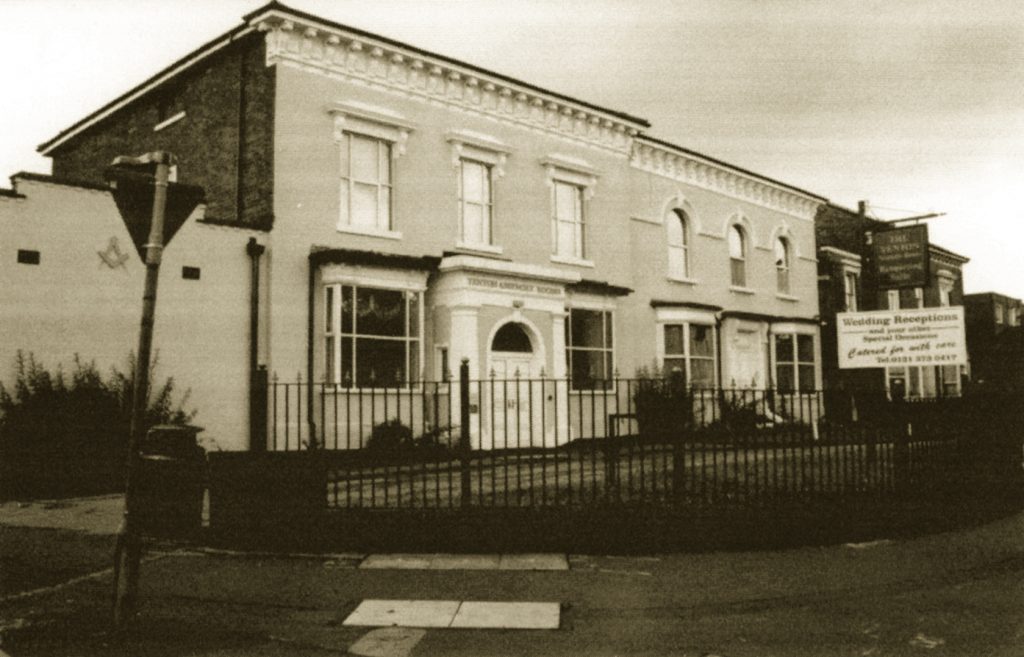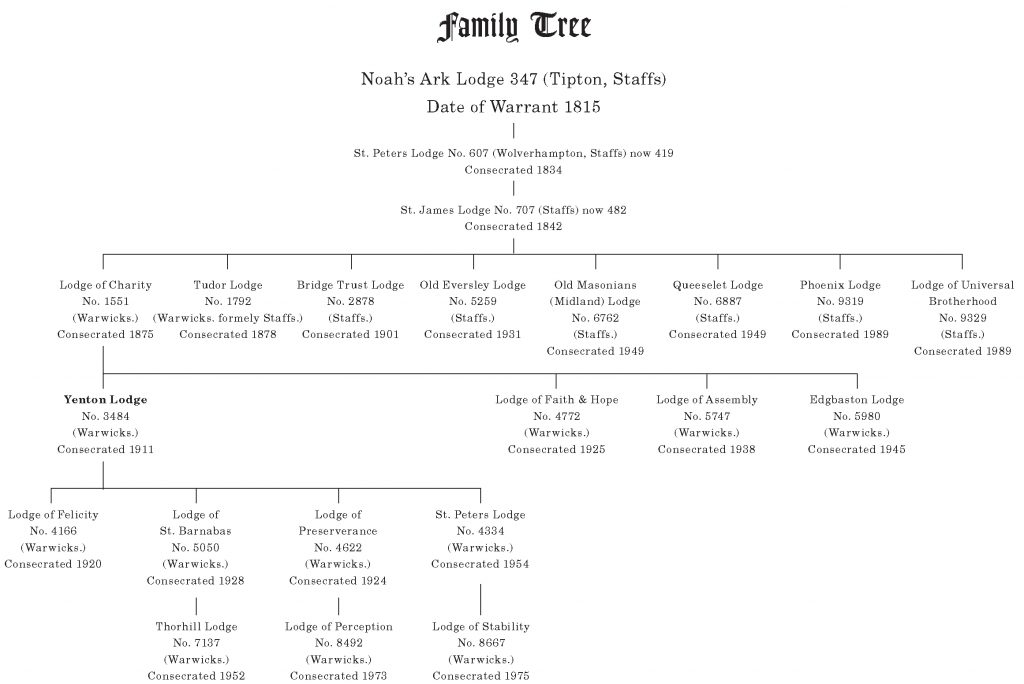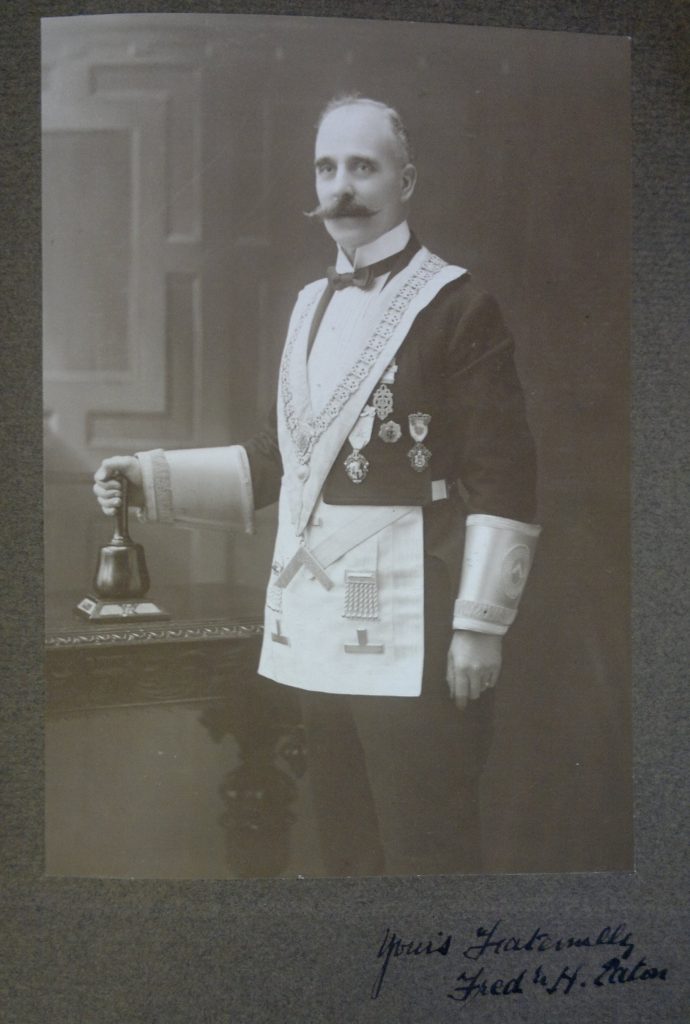History
Yenton was the very first Masonic Lodge to meet in Erdington, North Birmingham. It was specifically founded to be an Erdington Lodge. Consecrated on the 24th January 1911, Yenton Masonic Lodge held its first full meeting at The Public Hall, High Street, Erdington on 3rd February 1911.

The Public Hall, Erdington, Birmingham was intended to be the ongoing meeting place of Yenton Lodge but in 1912 the Local Authority decided to close the Public Hall and convert it into a theatre and cinema (known as the Palace). Cinemas were a new phenomenon in the early 1900s with all films being Silent Movies. Talking pictures did not appear until the 1920s.
Needing a new meeting place, the members of Yenton Lodge arranged with the Church House Committee of St Barnabas Church for the Lodge to meet at The Church House in High Street, Erdington. The building can still be seen, opposite St Barnabas Church. All Lodge meetings were held at The Church House from 3rd October 1912 until 4th May 1923.
In September 1919 the members of Yenton Lodge considered the feasibility of setting up a permanent Masonic Home. At this time there was no further action but Erdington Freemasonry was growing. Yenton Lodge had created three side order lodges, Yenton Royal Arch Chapter, Yenton M.M.M. (Mark Master Masons) and Yenton R.A.M. (Royal Ark Mariners). Membership of a Craft Lodge is the first entry into Freemasonry and is mandatory to be eligible to join other Masonic Orders. For more information about other Masonic Orders please visit the web site of the Provincial Grand Lodge of Warwickshire
Some of the members of Yenton Lodge were members of the Methodist Church in Erdington and they approached Yenton Lodge to sponsor their petition for a new temperance (Craft) lodge in Erdington. In 1919 the new lodge was formed with the name “The Lodge of Felicity No. 4166”.
The Church House Committee was becoming concerned as all of these Erdington Masonic Lodges were meeting at the Church House and their bookings were encroaching too much on availability. In Fact, the first application for the Lodge of Felicity to meet at the Church House was turned down. It was only after much discussion and persuasion that the Church House Committee relented. The committee made it clear that they would not accept any further lodges. That forced the freemasons to seek a more permanent Erdington Masonic home.
In 1921 a second emergency meeting of Yenton Lodge was called to discuss the setting up of an Erdington Masonic Hall. The meeting was held at the Christadelphian Hall in Orphanage Road, Erdington. An invitation was sent to all Erdington lodges to partake in the discussion and from the representatives present, a committee was formed.
This committee was charged to investigate the possibilities of finding suitable premises. A number of alternatives were discussed, among them were:-
a) A new building to be built on vacant land on what is now Barnabas Road off the High Street.
b) A similar scheme to be developed on land forming part of the Broadfield Estate (the old tram terminus), which is now a shopping area.
c) To convert a house in Gravelly Hill North on the corner of Jaffray Road (nearly opposite the present Rooms).
d) To convert no. 73 Gravelly Hill North, a large house built in 1853 which had been vacant for some time.
It was 1922 when option d) was identified and proved to be to preferred option. The owner of the property was a Doctor Frew. The property was freehold and the asking price was £1,300. It was inspected by the Committee and Worshipful Brother A. Harrison Smith, a builder and one of the founders of Yenton Lodge, he had also been Worshipful Master in 1916. W.Bro. Harrison Smith produced a feasibility plan for the conversion of no. 73 Gravelly Hill North into a Masonic Hall.
A new company, Yenton Masonic Hall Co. Ltd., was formed and the purchase and conversion went ahead. The work on the conversion was completed in the late summer of 1923.
On 23rd September 1923 the Yenton Masonic Hall was officially opened. There was a large gathering of Erdington Masons together with their wives and Masonic guests including many well known Erdington people. Among these was Dr. W. B. Featherstone, Hon. Secretary of the Church House Committee, which had played such an important part in the early development and growth of Freemasonry in Erdington.
Apart from minor roof damage, the building survived the bombing of World War Two. By 1946 the Company heard that the adjoining property, no. 75 Gravelly Hill North, was to be placed on the open market. After an examination of the building and extensive negotiations, the Company agreed to a price of £3,600, Freehold. At the time of the purchase the property was being used as a dancing school and a condition of the sale was that a Miss Deverson be allowed to continue running her dance school on a lease of £300 per annum.
Miss Deverson’s Dancing School lease on number 75 was due to expire in December 1951. A proposed draft plan was prepared to redevelop the property and a planning application for a building licence was submitted to the Local Authority. Due to the building restrictions and priorities in post war Britain, the application was refused. Miss Deverson immediately applied to the Company for renewal of her lease which the Company reluctantly agreed to for a further three years until December 1954.
The alterations and improvements eventually went ahead. The building has undergone a number of internal changes over the years but the front facade is still very much the original 1853 house.
Being 100 years old in January 2011, Yenton Lodge celebrated it’s Centenary on Friday 4th February 2011. The Centenary was a grand Masonic meeting and was held at the Erdington Masonic home, now known as Yenton Assembly Rooms and most importantly still nos. 73 – 75 Gravelly Hill North. Due to the large number of attendees, nearly 120 people sat down to dinner, special arrangements were made to increase bar, dining and car parking capacities.
Since that meeting, there has been an item added to the agenda of each meeting of Yenton Lodge to hear a summary of the meeting of 100 years ago. These small presentations have highlighted some subtle though important differences between meeting in those days and now. The calling notice for each meeting, Masonically named the Summons, always contained the following notice:-
NOTE- Trains leave New Street at 4.15 and 5.5 p.m. (No 2 Platform)
Trams leave Steelhouse Lane every few minutes.
Journey takes 25 minutes.
In the 1910s personal motorised transport was extremely rare. Local travel by train or tram was very common and Erdington was well served by both Birmingham Corporation Tramways and LMS Trains, being on the LMS route from Birmingham New Street to Lichfield. Erdington Station opened in 1862 on Sheep Lane, later re-named Station Street.
Throughout the history of Yenton Lodge, one thing stands out above all others. The fundamental Masonic principals of benevolence and charity have held strong and true. The generosity of the brethren and their willingness to support good causes has never waned.
The history of Freemasonry from the middle ages……
Download our Masonic family tree

The first Worshipful Master of the Yenton Lodge No. 3484 was Worshipful Brother Charles (Chas) Richards, a Past Master of Machen Lodge No. 1782 and St Laurence Lodge No. 2724 in the Province of Worcestershire. He was a Draper and resided at ‘Llanhydrock’, Kingsbury Road, Erdington. He would appear to have been a very generous man – see the notes about the meeting held on 5th November 1915 under “The Great War”.
At the Regular meeting of the Lodge held on Thursday April 4th 1912 the minutes record the following :-
“An Illuminated Address was then presented to Wor. Bro. Chas Richards by the Wor. Master on behalf of himself and Brother signatories and having paid tribute to his zeal in the Welfare of the Yenton lodge expressed the delight which these brethren felt at being able to give him some token of their appreciation and Regard. Wor. Bro. Chas Richards feelingly Responded and expressed his satisfaction that his labours were thought so highly of.”
Friday January 1st 1915, W.Bro. Frederick H. Eaton, one of the Founders, was elected Master Elect. His photograph in full regalia is contained in the first Minute Book.
